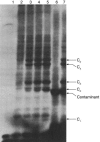The discovery of ubiquitin-dependent proteolysis
- PMID: 16230621
- PMCID: PMC1266097
- DOI: 10.1073/pnas.0504842102
The discovery of ubiquitin-dependent proteolysis
Abstract
In early 1980, Irwin A. Rose, Avram Hershko, and Aaron Ciechanover published two papers in PNAS that reported the astounding observation that energy-dependent intracellular proteolysis was far more complicated than the previously accepted models of lysosomal proteolysis or the action of ATP-dependent proteases such as bacterial lon. In fact, it has turned out to be even more complicated than they could have suspected. The general model of covalently attaching a small protein as a targeting signal has proved to be every bit as important to eukaryotic cells as the better understood modifications such as phosphorylation or acetylation. The key player in this modification, a small protein called ubiquitin (APF-1 in these papers), is the founding member of a large family of proteins containing the beta-grasp fold and is used as a posttranslational targeting signal to modify the structure, function, and/or localization of other proteins. The story of this discovery is a textbook example of the confluence of intellectual curiosity, unselfish collaboration, chance, luck, and preparation.
Figures



References
MeSH terms
Substances
LinkOut - more resources
Full Text Sources

